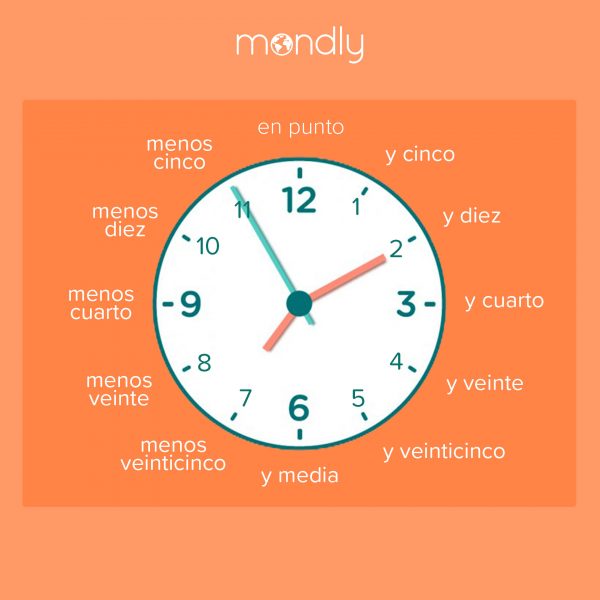
Horas Y Segundos: Un Guía Para Empezar

Horas Y Segundos: Un Guía Para Empezar
¿Que hora es? demands an answer! And no, we’re not talking about the Mexican soap opera for people who only had 3 weeks of Spanish in the 4th grade_(wink wink)_ . In all seriousness, how do you reply to the question that has been on everybody’s lips at one point? How do you tell the time in Spanish? Well, it’s time_(wink wink)_ to find out.
I know what you think and it’s true. We’re lucky enough to live in an era of rapid technological advancements. Even if you don’t own a watch, you probably have a smartphone. Asking or telling the time in Spanish or any other language may seem obsolete. But what if your phone’s battery is dead? I for one had a pretty interesting experience when I had to survive one week without a phone. I kept asking random people the time to make sure I wasn’t late and they looked at me like I was some kind of an alien. So yeah, knowing how to tell the time in Spanish can make all the difference!
One more thing! If you’ve learned how to count in Spanish , it will be extremely easy for you.
But first things first.

¿Que hora es? – how to ask for the time in Spanish
In order to tell the time in Spanish, you’ll first have to learn how to properly ask for the time in Spanish. You can never be too cautious. I’m just making sure you’re not missing that_fiesta española_ you spent weeks thinking about!
In addition to the now well-known_¿que hora es?_ which literally translates to “what hour is it?”, you can also ask_¿tiene hora?_ which is literally “do you have the hour?”. Easy enough!
The basics of Spanish time
To_decir la hora_ (“tell the time”) in Spanish, there are a few simple rules you’ll have to know.
First of all, always use the verb**ser** . No, not_estar_ , but_ser_ . If you don’t know what Spanish verbs are all about, you might want to check this little guide for beginners . To put it simply, time is a permanent entity that requires the use of the verb_ser_ .
Secondly, remember that only when talking about one o’clock, you’ll need to use the third person singular form of_ser_ . For all the other eleven hours, you can safely go with the plural form. Here’s how to tell the time in Spanish if the time is on the hour:
- Es la una. – It’s one o’clock.
- Son las dos. – It’s two o’clock.
- Son las tres. – It’s three o’clock.
- Son las cuatro. – It’s four o’clock.
- Son las cinco. – It’s five o’clock.
- Son las seis. – It’s six o’clock.
- Son las siete. – It’s seven o’clock.
- Son las ocho. – It’s eight o’clock.
- Son las nueve. – It’s nine o’clock.
- Son las diez. – It’s ten o’clock.
- Son las once. – It’s eleven o’clock.
- Son las doce. – It’s twelve o’clock.
As you can see, the feminine article (la/las) is used before the number. Why is that? Well, because it refers to_la hora_ . But again, remember that the singular form**la** will only be used in the case of“one o’clock” because we’re talking about a single hour.
Nota bene: If you prefer to use the 24-hour clock, you should say**son las dieciséis** (“it’s 16:00”) instead of son las cuatro (“it’s 4 o’clock p.m.”). But that will require a little more studying on your part. Don’t worry though. Spanish numbers are just as easy as learning how to tell the time. You can master them with Mondly faster than you can say Jack Robinson. You can get started here .
How do you say the time in Spanish after 30?
Now, the time is not always on the hour. So how do you say “half past”, “quarter past” and “quarter to” in Spanish? There are only two new words you need to remember:media and_cuarto_ .
- If it’shalf past the hour in Spanish, use the phrase_y media_ ;
- If it’s aquarter past the hour, use the phrase_y cuarto_ ;
- If it’sa quarter until the hour, use the phrase**menos cuarto** .
Here are some examples:
- 2:30 –Son las dos y media. – It’s two thirty.
- 1:15 –Es la una y cuarto. – It’s one fifteen.
- 5:45 –Son las seis menos cuarto. – It’s a quarter until six.

Telling time in Spanish – a visual guide
Hour + minutes in Spanish time
Wanna be a little more specific? Here’s how Spanish time works when you need to indicate the exact number of minutes that have past from the hour.
The simplest formula is es/son + las + hour + number of minutes. For example, if you want to say that it’s_3:29_ , you’ll say**son las tres veintinueve.**
Thus, the same as in English, there will be two ways in which you can indicate some hours in Spanish. If it’s 8:15, you can say:
- Son las ocho y cuarto. (“it’s a quarter past eight”)
- Son las ocho y quince. (“it’s eight and fifteen minutes”)
Different ways of telling time in Spanish
There are three formulas of telling time in Spanish. Here are different ways of telling it’s 3:10:
- es/son +las + hour + number of minutes –_Son las tres diez_
- es/son +las + hour + y + number of minutes –**Son las tres y diez**
- es/son +las + hour + con + number of minutes –**Son las tres con diez**
Which one do you prefer? Additionally, if we also count it_cuarto_ and_media_ , there are no less than four different ways to tell the time in Spanish. And you’ve just mastered them all!
How to indicate the time of day in Spanish
If you are using the 12-hour clock, you sometimes might want to also point out the time of day. For instance, “it’s two in the afternoon” translates to_son las dos de la tarde_ in Spanish. Not too complicated, is it? Here are some more times of day that might come in handy:
- mediodía – midday
- mañana – in the morning
- noche – at night
- madrugada – the middle of the night
- medianoche – midnight
- amanecer – dawn
- tarde – in the afternoon
To indicate that an event occurs at a specific time, use the formula a +la(s) + time :La clase de español empieza a las nueve – “The Spanish class begins at 9”.
Other useful time phrases in Spanish
- por la mañana – in the morning
- por la tarde – in the afternoon
- de la tarde – in the afternoon
- al mediodía – at noon
- a la medianoche – at midnight
- por la noche – in the evening or night
- de la noche – in the evening or night
- la mañana – morning or tomorrow
- mañana por la mañana – tomorrow morning
- pasado mañana – the day after tomorrow
- tarde – late
- temprano – early
- en punto – exactly or sharp (son las ocho en punto – “it’s exactly eight o’clock”)
- ayer – yesterday
- anteayer – the day before yesterday
- anoche – last night
- la noche anterior, anteanoche – the night before last
- el lunes que viene – next Monday
- el lunes pasado – last Monday
- la semana que viene – next week
- semana por medio – every other week
- la semana pasada – last week
- el año que viene – next year
- el año pasado – last year
- durante el día – during the day
A guide for telling the time in Spanish ends here but it doesn’t mean stop learning Spanish . Continue to master Spanish with daily lessons, quizzes, and practices.
Speak Spanish fluently in just 10 minutes a day
Do you want to speak Spanish fluently fast? Get Mondly, the award-winning language learning app that will help you speak Spanish as if you were Spanish-born.
It can be tricky to master Spanish pronunciation if you don’t actively live in Spain or Mexico. But with Mondly you’ll have access to a unique, fast and highly efficient learning method that allows you to learn Spanish naturally with practical topics, authentic conversations and bite-sized Daily Lessons.
Start using Mondly for free on your computer or download the app and learn Spanish fast anytime, anywhere.
Also read:
- [New] Permanently Quit YouTube Shorts Now for 2024
- 2024 Approved Explore Best 10 Free Srt Converter Apps Online
- 2024 Approved Paving the Way to YouTube Stardom Through Effective SEO Keywords
- Africa's Unspoken Language Wealth
- AI Ally in Gaming: Top 6 Approaches with ChatGPT
- Best Family App of Year on Google Play: Mondly Kids with Smart Controls
- Explorar O Português: Todas As Formas De Saudar
- I Mille Numero Italiani: Conoscenze Importanti
- In 2024, Apply These Techniques to Improve How to Detect Fake GPS Location On Xiaomi Redmi Note 12 Pro+ 5G | Dr.fone
- In 2024, Redefining Digital Space Alternative Video Hosting Sites
- Lerne Deutsche Wochenabschnitte Verinnerlichen
- Never Pay More: Mondly Premium - Forever Free
- Reinforce Revenue with Robust Rhetorical Capacity Building
- Top 10 Best Spy Watches For your Asus ROG Phone 7 | Dr.fone
- Unveiling Studio Magic Comprehensive XReview for 2024
- Title: Horas Y Segundos: Un Guía Para Empezar
- Author: Christopher
- Created at : 2025-02-04 20:11:10
- Updated at : 2025-02-10 22:41:07
- Link: https://mondly-stories.techidaily.com/horas-y-segundos-un-guia-para-empezar/
- License: This work is licensed under CC BY-NC-SA 4.0.